( Log In ) Log In is for TREC Teachers & Researchers only
  |
| Amy_Clapp |
 Jul 4 2005, 01:30 AM Jul 4 2005, 01:30 AM
Post
#1
|
 TREC Teacher    Group: TREC Team Posts: 84 Joined: 27-April 05 Member No.: 6 |
So, the funny thing about our stay at the Holy Name of Mary Parish in Tsiigehtchic was that there was no real way to darken the rooms at night to sleep (since it is light 24 hours a day), but a storm came in and it actually got quite dark out in the morning, so we ended up sleeping in. This was fine considering we didn’t have to be anywhere until 10:30 a.m. when we had our “spot” on the radio station with James Cardinal. Our plan was to do the radio interview, walk around town, go to the Canada Day festivities at 1:00 and then probably head out of town. So we headed to the Band Office (the Band Office is where all the people working for the government, like the chief and town planner, work) at about 10:20 to meet James Cardinal, and ended up having a cup of coffee with two guys that were in the office that day (even though it was a national holiday). At about 10:40 p.m. one of them called over to James Cardinal, and he informed us the radio show wasn’t going to happen that day because of the national holiday. Shucks….and by that time it was raining out again, so we went back to the church and waited out the rain. As we were sitting there, basically watching the river flow by, Max saw movement down by the fish camp, so we went to go check that out.
When we got to the fish camp Noel Andre had just left to check his nets, and his wife Alice said we were welcome to wait for him by the shore, which we did. When he showed up we reintroduced ourselves from the other day and asked if we could watch him deal with the fish.  This was fine with him. It was pretty funny because at that point we were asking him about where he put his fishing nets and I asked “Why is that a good place to fish?” and Noel, matter of factly, said back, “Because that is where the fish are.” Good answer, hugh? Max and I brought the bucket to his camp, and his wife came out and together the two of them were the most efficient team cutting and cleaning the fish. After 42 years of doing this, they have it down pat.  After the cut them, they put them outside next to a fire to dry for a few hours and then the fish moves into the fish house where it will stay for 2-3 days depending on what the weather is like outside. 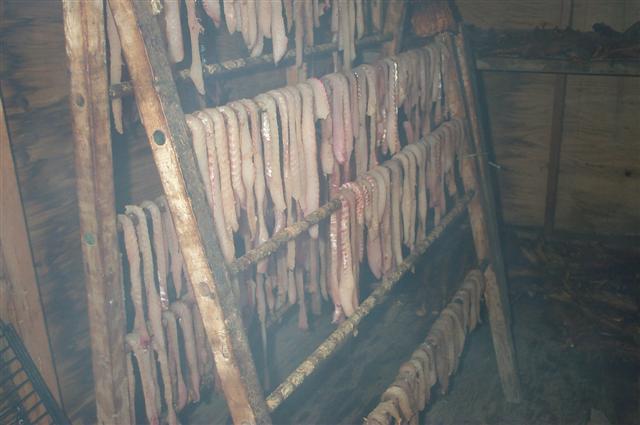  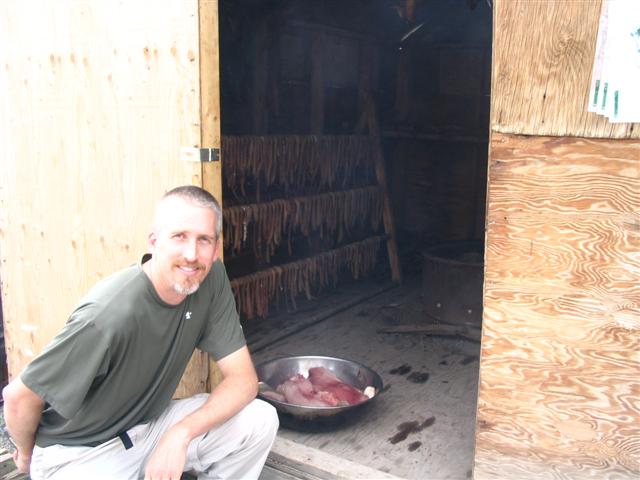 Noel and Alice are considered elders in the community, and they are both willing to teach the younger kids how to keep up the fishing tradition. However, as Noel said, not too many of the kids are interested in the fishing although some of their grandchildren do work with them in the summer. Noel and Alice work these fish (Coney) until the middle of July and by that time they have cleaned and smoked about 400 fish. Then White Fish season starts. The White Fish are smaller and easier to clean, and they dry and smoke those and then eat off of their stock for the winter. Additionally, they trade some of their fish with the women who pick berries, as Alice said she would much rather clean fish than bend over picking berries all day. I was amazed at how little waste came out of the whole process. Here is a picture that shows three fish that were cut and cleaned, the pile of stuff at the left hand top of the table is the waste. 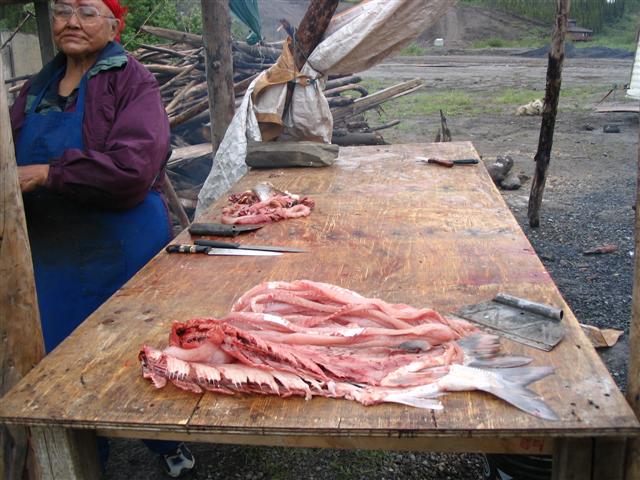 However, sometimes many of the fish drown in the net before Noel gets to them, especially when he checks the net for the first time in the morning. If that happens, the drowned fish meet goes to make dog food since. We tried some of the dried, smoked fish and it was interesting. It didn’t taste very fishy at all. Hanging out at the fish camp was a lot of fun for both Max and me. It gave us both a glimpse into what life is like for the elders in this community and also a little bit of an idea of what life was like for the Gwich’in of Tsiigehtchic long ago. It was fantastic to see some of the old traditions still in practice and thriving. After the fish camp, we went to return the church key and then went to the gym where we heard the Canada Day festivities were taking place. We got there and found out that the games were postponed until the next day when hopefully the weather would be better. However there were about 10 kids hanging out in the gym. Of course, due to Max’s height (6 feet 5 inches) a few of the boys asked Max to play basketball, and a small game of pick-up pursued.  While Max was playing basketball, I got to talk to some of the younger kids who were watching. As usual, the kids charmed us! 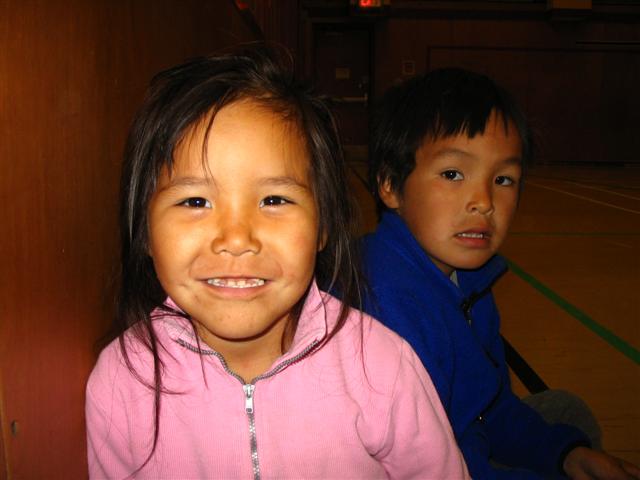 Then we were on our way back to Inuvik. The Dempster Highway was pretty interesting being wet from all the rain. First of all, all the cars were completely, and I mean completely covered with mud. 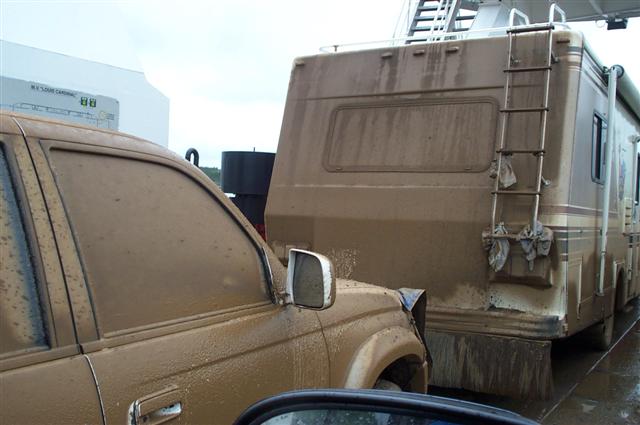 Second, it was like driving on ice because the treads in the tires got completely filled in with mud—so we were fishtailing a bit—but Max did a great job driving and we made it back to Inuvik in one piece.  Next, we are off to Yellowknife, which is the capital of the Northwest Territories. We don’t have much planned for the next two days before we trek all the way back down to Seattle, to go back up to Alaska, but things always seem to happen on trips like this…. Happy Fourth of July!!! Amy |
| Tom_Crumrine |
 Jul 4 2005, 12:09 PM Jul 4 2005, 12:09 PM
Post
#2
|
 TREC Teacher    Group: TREC Team Posts: 188 Joined: 27-April 05 Member No.: 9 |
Amy,
Sounds like your trip is going well so far. I have read a bit about the fish camps that occur in the arctic and I know how the smoking of the fish goes and the prep work. What I have been wondering is where exactly do they put the fish that is smoked until they are ready to eat it? Do they have a special box? Do they keep it hanging in a room somewhere? Say it is January 3rd and they wanted some fish to eat for lunch, where is the storage spot for it? This may be a weird question but I have been wondering about it for days for some reason. Thanks, Tom |
  |
2 User(s) are reading this topic (2 Guests and 0 Anonymous Users)
0 Members:

|
NSF Acknowledgment & Disclaimer | Time is now: 2nd November 2024 - 01:31 PM |
Invision Power Board
v2.1.7 © 2024 IPS, Inc.








